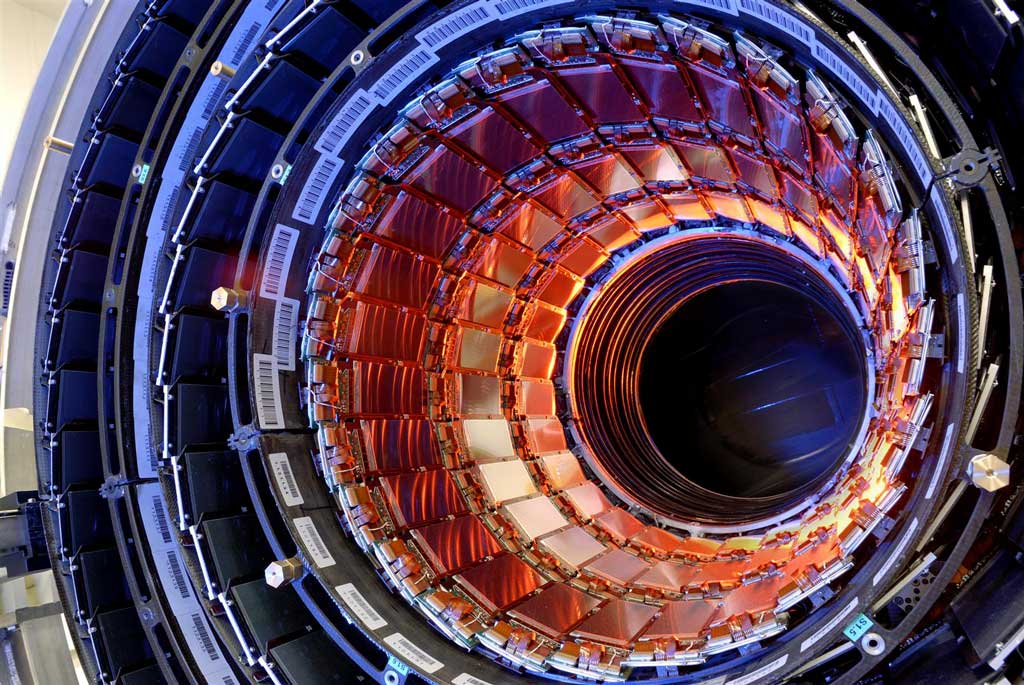Key Takeaways:
When particle accelerators collide protons or lead ions, they do so within special sections of an instrument that can capture fine details. These huge detectors are like giant digital cameras that take photographs of the outcome of each collision. (Researchers keep only a subset of these photographs, but that is another story.) These pictures record information about each outgoing particle produced in the collision.
Unlike photographs where the detector is the film’s two-dimensional surface, particle detectors are thick and multi-layered (i.e., three-dimensional), and the outgoing particles often pass though many (or all) layers of the apparatus and interact with those materials as they go. These interactions allow us to measure such properties as the charge, momentum, and energy of each of these particles. Furthermore, the many different systems in the detectors help us determine what type of particle it is. For instance, a muon is the only particle that can travel from the detector’s center, where the collision occurred, to the outermost tracking layer; if we detect something in the outer region, it is a muon.
We need to measure as much about each collision as possible because they are complicated events, and piecing together exactly what happened is a challenging business. Only by measuring very precisely what each collision created can we determine if a Higgs boson, or some other new particle, was made.
When two bullets collide, the energy carried by individual particles within each bullet is rather small. But particles traveling within an accelerator carry enough energy that a collision will produce other particles. In fact, a typical collision of two protons makes hundreds of particles; lead ion collisions will make many more. At these high energies, the collision occurs between the sub-components of the protons — the quarks and the gluons — and the produced particles can be anything that the symmetries of nature allow. That means that energy, momentum, and charge must be preserved, but quantum mechanics theory allows any final state that conserves these properties. Some states are more likely than others, and it is our job to search for the more unlikely, and more interesting, ones, which requires these advanced detectors.
Unlike photographs where the detector is the film’s two-dimensional surface, particle detectors are thick and multi-layered (i.e., three-dimensional), and the outgoing particles often pass though many (or all) layers of the apparatus and interact with those materials as they go. These interactions allow us to measure such properties as the charge, momentum, and energy of each of these particles. Furthermore, the many different systems in the detectors help us determine what type of particle it is. For instance, a muon is the only particle that can travel from the detector’s center, where the collision occurred, to the outermost tracking layer; if we detect something in the outer region, it is a muon.
We need to measure as much about each collision as possible because they are complicated events, and piecing together exactly what happened is a challenging business. Only by measuring very precisely what each collision created can we determine if a Higgs boson, or some other new particle, was made.
When two bullets collide, the energy carried by individual particles within each bullet is rather small. But particles traveling within an accelerator carry enough energy that a collision will produce other particles. In fact, a typical collision of two protons makes hundreds of particles; lead ion collisions will make many more. At these high energies, the collision occurs between the sub-components of the protons — the quarks and the gluons — and the produced particles can be anything that the symmetries of nature allow. That means that energy, momentum, and charge must be preserved, but quantum mechanics theory allows any final state that conserves these properties. Some states are more likely than others, and it is our job to search for the more unlikely, and more interesting, ones, which requires these advanced detectors.
Patrick Fox
Fermi National Accelerator
Laboratory, Batavia, Illinois
Fermi National Accelerator
Laboratory, Batavia, Illinois










